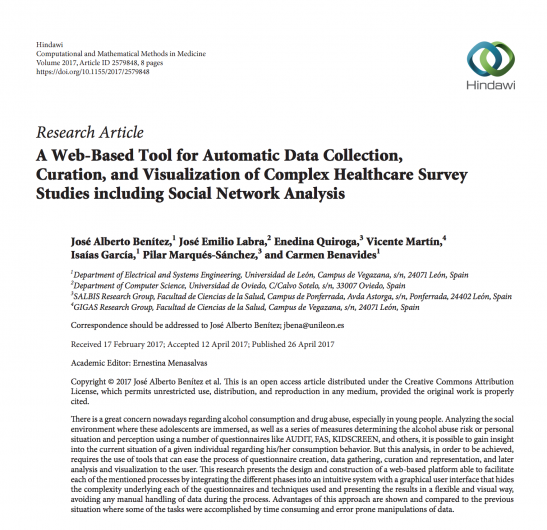Computational and Mathematical Methods in Medicine
Volume 2017 (2017), Article ID 2579848, 8 pages
https://doi.org/10.1155/2017/2579848
A Web-Based Tool for Automatic Data Collection, Curation, and Visualization of Complex Healthcare Survey Studies including Social Network Analysis
1Department of Electrical and Systems Engineering, Universidad de León, Campus de Vegazana, s/n, 24071 León, Spain
2Department of Computer Science, Universidad de Oviedo, C/Calvo Sotelo, s/n, 33007 Oviedo, Spain
3SALBIS Research Group, Facultad de Ciencias de la Salud, Campus de Ponferrada, Avda Astorga, s/n, Ponferrada, 24402 León, Spain
4GIGAS Research Group, Facultad de Ciencias de la Salud, Campus de Vegazana, s/n, 24071 León, Spain
Correspondence should be addressed to José Alberto Benítez
Received 17 February 2017; Accepted 12 April 2017; Published 26 April 2017
Academic Editor: Ernestina Menasalvas
Copyright © 2017 José Alberto Benítez et al. This is an open access article distributed under the Creative Commons Attribution License, which permits unrestricted use, distribution, and reproduction in any medium, provided the original work is properly cited.
Abstract
There is a great concern nowadays regarding alcohol consumption and drug abuse, especially in young people. Analyzing the social environment where these adolescents are immersed, as well as a series of measures determining the alcohol abuse risk or personal situation and perception using a number of questionnaires like AUDIT, FAS, KIDSCREEN, and others, it is possible to gain insight into the current situation of a given individual regarding his/her consumption behavior. But this analysis, in order to be achieved, requires the use of tools that can ease the process of questionnaire creation, data gathering, curation and representation, and later analysis and visualization to the user. This research presents the design and construction of a web-based platform able to facilitate each of the mentioned processes by integrating the different phases into an intuitive system with a graphical user interface that hides the complexity underlying each of the questionnaires and techniques used and presenting the results in a flexible and visual way, avoiding any manual handling of data during the process. Advantages of this approach are shown and compared to the previous situation where some of the tasks were accomplished by time consuming and error prone manipulations of data.

